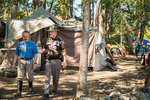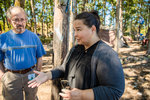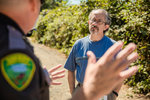














An encampment at the end of Centralia’s Eckerson Road with a regularly-fluctuating population of people experiencing homelessness was the backdrop for a tour of elected and appointed officials from throughout the area on Thursday, as it has been frequently in the last few years.
Currently, around 24 people live there.
Officials from Lewis County, the state Legislature, the cities of Centralia and Chehalis and Riverside Fire Authority gathered at the end of the road in the afternoon in the Blakeslee Junction area sporting rubber boots before walking into the makeshift neighborhood as a group.
Most of the year, the area is muddy. Contributing to their footwear choices, they said, was the potential for coming across human waste, broken glass and more.
“It’s dangerous. It’s not habitable,” said Meja Handlen, interim director of Lewis County Public Health & Social Services.
Meeting the group near the end of the road was resident Chuck Wiegard, who lives on the far corner of the encampment and has been a leader of sorts in its organization. Handlen said he’s lived there at least nine years. Wiegard wasn’t exactly leading the tour, but was adding commentary along the way. He told officials in the last week, the community has had four overdoses take place.
Reporting back on the visit during the Lewis County Mayors Meeting on Friday, Commissioner Sean Swope said, “Luckily, they have Narcan at that homeless encampment. But it’s just a matter of time before someone — or not just someone, people — start dying because of the amount of drugs that are going on in that area. And not just with that. It’s just how severe the drugs are today.”
Swope told The Chronicle that Wiegard said the life-saving opioid overdose medication, naloxone, also known by the brand name Narcan, had been provided to the encampment community by Gather Church in Centralia.
Due to its proximity to Interstate 5, the land is under the jurisdiction of Washington state Department of Transportation (WSDOT). Through an interlocal agreement, issues are managed there by the Lewis County Sheriff’s Office and medical or fire calls are handled by Riverside Fire Authority.
Firefighter Kevin Anderson and Captain Ken Colombo from Riverside were guests on the tour Thursday. Among their concerns with the area are major fire hazards presented with vehicles, fire pits, grills and other machinery being so close to dry vegetation in the encampment.
Anderson added that residents don’t have access to traditional home utilities to keep warm, prompting them to start fires. He said the fire authority is often called to the area for smoke investigations for that reason.
“We do try to educate,” Anderson said. “We educate everybody who we go out and visit who are burning when they’re not supposed to be burning. For others, it’s easier said than done.”
The tour was organized by Swope, who has recently expressed unease with the way Lewis County spends Department of Commerce dollars on homelessness: to the tune of $22 million in the last two years. Multiple times this summer, he’s taken time in public meetings to make clear his belief that “the system is broken” and “government is failing its citizens.”
The county recently hired a new health officer in Joe Wiley, a recently-retired Centralia pediatrician. The tour was partly a chance for seasoned officials to show Wiley pervasive health hazards in the encampment and partly a piggyback off recent momentum in the conversation about homelessness between Swope and others.
Asked the main intention behind Thursday’s meeting, Swope said he wanted to have “all hands on deck, just knowing the crime here is going up and we’re getting more and more calls with our law enforcement.”
While the structure is still unknown, the county is weighing the formation of an advisory committee on homelessness, with stakeholders from various services, agencies and cities.
As it is across the state, the issue of homelessness is tied up in problems around services for substance abuse disorder and other mental illnesses, affordable housing and much more.
While the idea of disbanding the encampment has been entertained, the question remains: Where would residents go?
As it works to establish a year-round shelter in 2023 on Kresky Avenue, the county has been providing beds for people facing homelessness through the Salvation Army. However, when the low number of beds being used at the shelter was brought up in Friday morning’s Mayors Meeting, Centralia Mayor Kelly Smith Johnston said there are issues with the shelter’s safety and sanitation that may be discouraging folks from staying there.
Two clients of the shelter have stopped at The Chronicle to report issues with rodents at the shelter this year.
Smith Johnston said the city has been collaborating with the Salvation Army to address the issue, which has been part of the permit renewal process with the county, adding that the organization has come a long way toward eradicating the problem.
Besides facilitating community-wide conversation, the steps necessary to fix what Swope described as “inhumane” living conditions at Blakeslee Junction are still gray. For example, if the sheriff’s office is called to the area for crimes, he said, “Who do you ticket?”
Similarly, Handlen said many people have said the county should provide port-a-potty services to the area in order to prevent the accumulation of human waste there, which could become a serious health hazard for the community at large during a flood event. However, she said if the county went ahead with those services, WSDOT would see that as them sanctioning the encampment and would stop treating it as their responsibility.
Swope and Handlen both recently mentioned that the $22 million from commerce has not come with enough strings of “accountability,” as in, those who benefit from the funding are not required to meet certain benchmarks of success by service providers that would appear to benefit them or the community.
This mentality has been criticized by Gather Church’s co-pastor, Patty Howard, who previously told The Chronicle using blanket benchmarks for the diverse population of homeless people locally overlooks the potential personal goals those people might be setting and making.
“We have to meet people where we are, we have to. To do any less is to take away some of their humanity, and I refuse to do that,” Howard said earlier this summer.
Asked how to strike the balance between accountability meant to help people out of homelessness without pushing people away from services entirely, Handlen said Thursday, “There’s always going to be organizations that want to help people. Those organizations may or may not be funded by the county or the cities, but there will be agencies who just want to help. If people want to get help, they can always get the help. … Are those services from us? They might not be, but would they be from a faith-based organization or just concerned community members? That’s great, but we need that circle to be closed so it’s safe, so it’s healthy.”